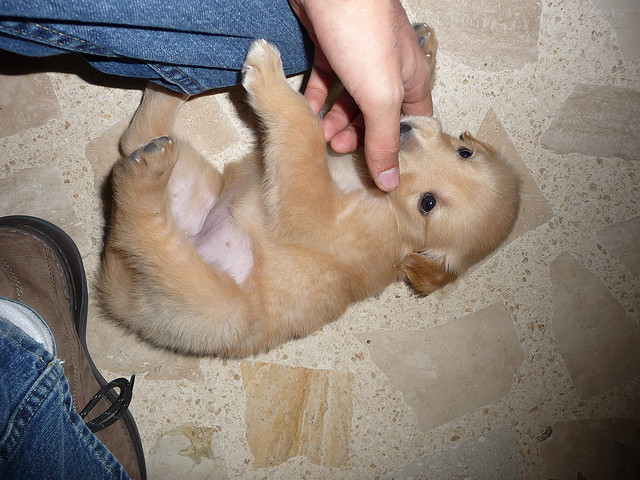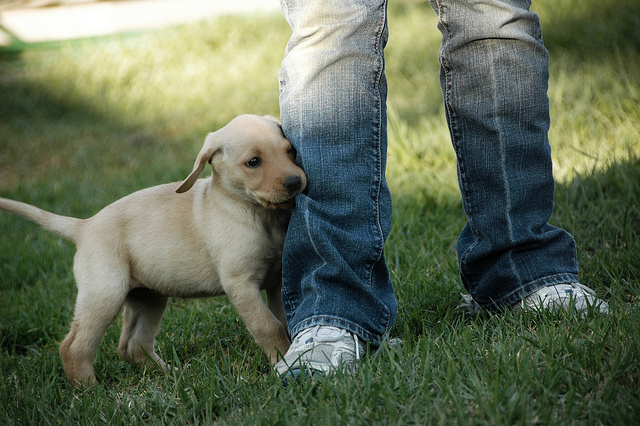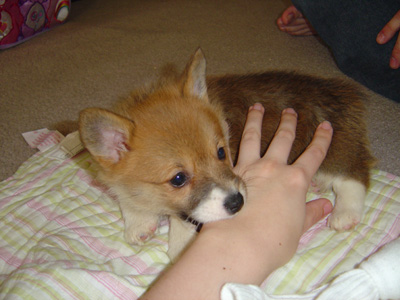
Dog Bite Prevention week is coming up, which means it’s a great time to think about biting dogs and how to get them to stop. A puppy may start out with small bites or what seems like play, but if you let him keep doing it, eventually those bites will become serious and you will be faced with a decision no dog owner ever wants to have to make.
Luckily, it is fairly easy to get a puppy to learn “bite inhibition” or to have a “soft mouth” – meaning if he does put his mouth on you, he won’t bite down hard. Here are four times your puppy may bite, and what you should (and should not) do in these circumstances.
Play
One of the main factors in teaching your puppy to not bite is how you play with him. If you rough-house with your pup and use your hands to wrestle his belly, playfully push his face, etc., don’t act surprised when he bites those hands. You are using them as toys and toys are okay to bite.
FIRST RULE: DON’T USE YOUR HANDS AS TOYS!

Instead, always have an appropriate toy to play with. Great choices are:
- Tug toys such as ropes, braided fleece and faux fur tugs are great
- Sturdy stuffed animals – Tuffy’s are good
Anything that is big enough that your dog can have a hold of without also biting your hand is a good toy.
Then, when you play, if you feel your dog’s mouth/teeth on you at all – stop play immediately! Get up and/or move away (taking the toy with you). Same goes for the puppy who chases and bites your ankles – stop moving immediately.

This teaches your puppy that if he bites, you came stops. It can be helpful to tether your puppy to something he can’t move while working on this, so you can walk away and he can’t follow you.
Wait until your puppy appears calm, and then resume play.
Restraining/Handling
A lot of puppies bite when you are trying to do anything restraining – toweling, nail clipping, brushing, putting on a collar or harness, etc.
SECOND RULE: DON’T FORCEFULLY HANDLE YOUR DOG!
Instead, teach him to enjoy these activities through the use of rewards. Pair handling with treats, praise and/or play.
Keep the sessions short. So only brush him for a few seconds and then release him to “go play.”

Teach any kids around the proper way to touch a dog. Use examples they can understand, such as “would you like it if someone pulled on your braid?” or “how does it feel when you get teased at school?”
If you find your puppy has a real issue with being touched (my youngest used to scream when I held him, now he is the dog in this video), get help from a certified professional dog trainer.
Fear
Some puppies may bite out of fear. For example, you come at them with a hair dryer and she bites you (or it).
THIRD RULE: DO NOT FORCE YOUR DOG INTO ANYTHING!
If you are dealing with fear, the worst thing you can do is think, “If I force her, she will see there is nothing to be afraid about and ‘get over it.’” I can assure that will not happen. Instead, you will make the fear worse and your puppy will grow into an adult fear-biter.
Avoid doing anything what will make it worse. For example, holding your puppy while someone else blow drys her. Next time to go to hold your puppy, she is going to run from you and/or bite you in anticipation of what happened last time. You just created a second problem.

Basically, you will start slowly, with your puppy in a situation where she is still calm enough to accept food and not bite. You will gradually build up by pairing the scary thing or situation with food. However, you should work with a certified professional dog trainer to overcome these obstacles. The triggers and the best way to get your puppy over them will be unique to your dog.
Guarding
One of the other main reasons a puppy may bite is if he is a resource guarder. He may guard food, space, toys, you, or all of the above.
FOURTH RULE: DO NOT TRY AND TAKE ANYTHING FROM A GUARDER!
You don’t want to be bit and you don’t want him to find out that biting you gets you to drop and leave whatever you were taking from him. If that happens, you have reinforced his behavior.

Instead, work on teaching your dog to trade – I give you something, you give me what you have – as long as it is safe to do so.
Feed him his meals from your hand (work on training for his meals!) so he sees you as someone you gives food and not as someone who may take it.
Keep him separate from any other animals in the house during meal time, play time (if he toy guards), etc. Waiting until he has abandoned something and then go and pick it up. Don’t leave things lying around the house – some guarders will “go for you” if they see you move toward one of “their” items.
Like fear, guarding is best worked on in partnership with a certified professional dog trainer. You do not want to make a mistake and make the situation worse.
